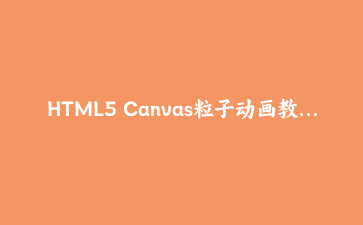本文详细讲解如何使用HTML5 Canvas和JavaScript创建高性能的交互式粒子动画效果。
介绍
粒子动画是现代网页设计中常见的视觉效果,它可以为网站增添动态和交互性。本文将指导您如何使用HTML5 Canvas和纯JavaScript创建一个高性能的粒子系统,该粒子系统会响应用户的鼠标移动。
我们将从基础开始,逐步构建一个完整的粒子动画效果,适合用于网站背景或特定UI元素。
环境设置
首先创建一个基本的HTML文件结构:
<!DOCTYPE html>
<html lang="zh-CN">
<head>
<meta charset="UTF-8">
<title>Canvas粒子动画</title>
</head>
<body>
<canvas id="particleCanvas"></canvas>
<script>
// JavaScript代码将在这里
</script>
</body>
</html>创建基础Canvas
我们需要设置Canvas元素以填充整个窗口,并处理窗口大小调整:
const canvas = document.getElementById('particleCanvas');
const ctx = canvas.getContext('2d');
// 设置canvas尺寸为窗口大小
function resizeCanvas() {
canvas.width = window.innerWidth;
canvas.height = window.innerHeight;
}
// 初始调整大小
resizeCanvas();
// 监听窗口大小变化
window.addEventListener('resize', resizeCanvas);创建粒子类
接下来,我们创建一个Particle类来管理每个粒子的属性和行为:
class Particle {
constructor(x, y) {
this.x = x;
this.y = y;
this.size = Math.random() * 5 + 1;
this.speedX = Math.random() * 3 - 1.5;
this.speedY = Math.random() * 3 - 1.5;
this.color = `hsl(${Math.random() * 360}, 50%, 50%)`;
}
update() {
this.x += this.speedX;
this.y += this.speedY;
// 边界检查
if (this.x > canvas.width || this.x canvas.height || this.y < 0) {
this.speedY = -this.speedY;
}
}
draw() {
ctx.fillStyle = this.color;
ctx.beginPath();
ctx.arc(this.x, this.y, this.size, 0, Math.PI * 2);
ctx.fill();
}
}实现动画循环
现在创建粒子数组和动画循环函数:
const particles = [];
// 初始化粒子
function init() {
for (let i = 0; i < 100; i++) {
const x = Math.random() * canvas.width;
const y = Math.random() * canvas.height;
particles.push(new Particle(x, y));
}
}
// 动画循环
function animate() {
// 清除画布,使用半透明黑色实现拖尾效果
ctx.fillStyle = 'rgba(0, 0, 0, 0.1)';
ctx.fillRect(0, 0, canvas.width, canvas.height);
// 更新并绘制所有粒子
for (let i = 0; i < particles.length; i++) {
particles[i].update();
particles[i].draw();
}
requestAnimationFrame(animate);
}
// 启动动画
init();
animate();添加交互功能
让粒子对鼠标移动做出反应,创建更吸引人的效果:
let mouseX = 0;
let mouseY = 0;
canvas.addEventListener('mousemove', (event) => {
mouseX = event.x;
mouseY = event.y;
// 鼠标移动时添加新粒子
for (let i = 0; i < 5; i++) {
particles.push(new Particle(mouseX, mouseY));
}
});
// 修改Particle类的update方法,添加鼠标交互
// 在Particle类中添加以下方法
interact(mouseX, mouseY) {
const dx = mouseX - this.x;
const dy = mouseY - this.y;
const distance = Math.sqrt(dx * dx + dy * dy);
if (distance < 100) {
// 鼠标附近的粒子受到排斥力
const force = (100 - distance) / 100;
this.speedX -= dx * force * 0.01;
this.speedY -= dy * force * 0.01;
}
}
// 然后在动画循环中添加交互调用
function animate() {
ctx.fillStyle = 'rgba(0, 0, 0, 0.1)';
ctx.fillRect(0, 0, canvas.width, canvas.height);
for (let i = 0; i 500) {
particles.splice(0, 50);
}
requestAnimationFrame(animate);
}性能优化技巧
为了确保动画流畅运行,特别是在移动设备上,我们需要进行一些优化:
// 1. 使用离屏canvas进行缓存
const bufferCanvas = document.createElement('canvas');
const bufferCtx = bufferCanvas.getContext('2d');
// 2. 减少粒子数量或根据设备性能调整
const particleCount = window.innerWidth {
isPageVisible = !document.hidden;
if (isPageVisible) {
animate();
}
});总结
通过本教程,您已经学会了如何使用HTML5 Canvas和JavaScript创建交互式粒子动画。这种效果可以应用于网站背景、登录页面或作为数据可视化的基础。
您可以进一步扩展这个基础系统:添加粒子之间的连线、实现不同的颜色方案、创建粒子吸引而非排斥的效果,或者添加触摸支持用于移动设备。
Canvas动画是前端开发中强大的工具,掌握它可以为您的项目增添独特的视觉吸引力。














